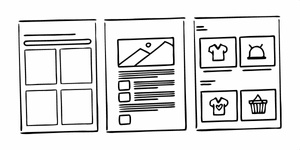Optimizing Shopify Category Pages with CRO #

Category pages are crucial for helping customers find what they want — but many Shopify stores struggle with poor structure, slow loading, and uninspired UX. At CRO Media, we've helped stores fix that using solid conversion rate optimization (CRO) strategies that improve flow, search visibility, and ultimately, sales.
Why Most Shopify Category Pages Fall Flat #
Many store owners use default Shopify themes and think that's enough. But a wall of products, no filters, and generic content usually means users bounce fast.
Even worse? Search engines don't get enough structure to rank them well. That's where a Shopify SEO audit reveals just how much is being left on the table.
One fix we love is interlinking related collections — like "Winter Jackets" and "Waterproof Gear." Shopify doesn’t support nested collections by default, but you can fake it with smart linking. This helps both users and bots understand the store layout.
Layout and Filters: The Non-Negotiables #
A good category page needs:
- Clear filters (size, color, material, price)
- Large, clean visuals
- Short, sharp descriptions
- Obvious CTAs
We often see sites where filters are missing or buried. That’s a conversion killer. When we do a CRO audit, we always push for filter usability — it’s one of the quickest wins.
Page Speed: Yes, It Still Matters #
Every second your page takes to load, you lose sales. A 1-second delay can cost you 7% in conversions. That’s huge.
We improve this by:
- Compressing images
- Minimizing third-party scripts
- Custom coding where needed
It’s part of what we check during a technical audit, and it’s especially important on mobile.
What If My Theme Sucks? #
That’s where custom development comes in. You don’t need to overhaul your whole theme — just improve what matters:
- Smarter filtering
- JSON-LD for better schema
- Layout that fits your brand and product flow
Your dev stack shouldn’t get in the way of your CRO.
Content Is Not Optional #
Product cards alone won’t rank. You need:
- Rich descriptions
- Category intros
- Internal links between collections and related products
These small changes boost UX and SEO together. Add schema, optimize headings, and connect the dots. If you're not sure how, start with our Shopify SEO audit.
Always Be Testing #
Once you’ve made these changes, it’s not over. Use:
- A/B testing
- Heatmaps
- Scroll tracking
...to find what’s working and what’s not. The best Shopify stores don’t launch perfect — they improve fast.
Final Thoughts #
If your Shopify category pages are boring, broken, or just not converting — it's time for a fix. CRO Media specializes in spotting the leaks and plugging them with smart dev, UX fixes, and SEO.
Start with a CRO or SEO audit and let’s turn your collections into high-converting machines.
You might also enjoy:
Shopify for $1/month + Earn 1% of all sales as subscription credits, up to $10,000.
Glossary Terms in This Article:
Frequently Asked Questions
Quick Answers for Shopify CRO
- Why do Shopify category pages often have low conversions?
- Many Shopify stores have poorly structured category pages, making it hard for users to navigate. Our [Shopify SEO audit services](/shopify-seo-audit/) can help improve the layout, filters, and overall user experience.
- How does page speed affect Shopify category page performance?
- A slow page load can reduce conversions by 7%, making fast-loading pages essential. Get a complete [technical SEO audit](/shopify-seo-audit/) to identify speed optimization opportunities.
- What role does content structure play in Shopify category pages?
- Well-structured content with internal links, SEO-friendly descriptions, and schema markup can improve both search engine visibility and user experience. A [Shopify SEO analysis](/shopify-seo-audit/) can help identify content optimization opportunities.
- How can Shopify category pages be optimized for SEO?
- Through a comprehensive [Shopify store audit](/shopify-seo-audit/), we can improve SEO on category pages through optimized content, internal linking, and schema markup that makes the pages easier for search engines to understand.
- How does CRO improve the user experience on Shopify category pages?
- CRO enhances navigation, introduces better filtering options, and ensures the pages load quickly, leading to a better overall shopping experience. Get a thorough [SEO audit for Shopify](/shopify-seo-audit/) to identify UX improvement opportunities.